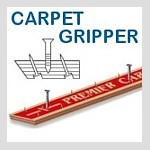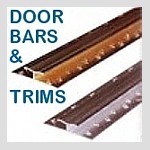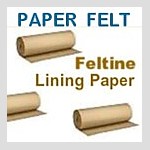Help and advice in choosing carpet underlay ... by Clive the Carpet Fitter

DO I NEED A CARPET UNDERLAY ?
If your new carpet is of a secondary backed, jute backed or 'action back' type, the answer is probably yes. These carpets are intended for use with a separate underlay, except in certain commercial installations where the carpet can be glued directly to the sub floor. If your new carpet has a textile or felt backing, these can be laid directly to the sub floor, so saving on cost, but this option will compromise on both comfort and energy efficiency, the latter due to increased heat loss through the floor. Another downside to laying these carpets without an underlay is that carpet gripper cannot be used to stretch the carpet to the shape of the room, often giving a less precise finish to the installation.
CAN I RE-USE MY OLD CARPET UNDERLAY ?
Re-use of old carpet underlay is generally not recommended; it may look fine at this stage, but could fail during the lifetime of the carpet, rendering any guarantee on the carpet as invalid. Would you buy a brand new car and ask the garage to fit your old tyres? Of course not, you would want the new car to perform exactly as it should. Re-use of old carpet underlay is, as they say, penny wise and pound foolish.
HOW MUCH SHOULD I PAY FOR CARPET UNDERLAY ?
The answer to this one is 'As much as you can afford to.' Underlays do vary in quality and suitability, but generally speaking, when comparing ranges, the more you pay for the carpet underlay, the better the quality it will be, giving extended life to your carpet. That said, before you spend out on that new carpet underlay, do compare prices, as the internet based companies are often just a third of the price that you would pay to one of the 'big' carpet stores. A similar situation applies to carpet gripper, where a full 500 foot box of the product can be purchased for less than £40 online, but the equivalent quantity could cost you a staggering £270 in one of the big stores.
ANY TIPS FOR LAYING ?
Firstly, make sure you purchase the correct amount of carpet underlay and be aware that unlike purchasing carpet, where you buy to the nearest width to fit your room, underlay can be purchased to a net amount. So if, for example, your rooms total 50 square metres but you are having to buy 54 square metres of carpet to comply with the widths available, you still only need 50 square metres of underlay. No point in buying a product simply to throw it away. Be sure to lay the carpet underlay the correct way up, if it has a printed side, this should be laid uppermost. If it has a cloth, film or paper backing, this should be laid uppermost. Taping the joins is a good idea and most companies will stock a product suitable for this purpose.
WHERE TO BUY CARPET UNDERLAY?
In most instances it is much cheaper to buy online where savings can be up to 75% off retail prices. At the time of writing this article a brand leading underlay from a major UK manufacturer can be bought online for as little as £2.33 square metre as opposed to a major retaler charging £7.49 square metre (both prices calculated ex-VAT). Do check delivery costs, though, as some sites make only a small one-off charge for delivery, whilst some sites can charge a lot more. Again at the time of writing, this site charges just £12.95 for delivery to most areas, regardless of how many items you order, so no matter whether it's one roll or a hundred, that one £12.95 cost covers it all.
WITH SO MANY CARPET UNDERLAYS AVAILABLE, WHICH ONE SHOULD I CHOOSE?
PU FOAM UNDERLAY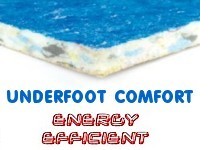 Unquestionably the most popular type of carpet underlay sold in the UK nowadays, this type of underlay has been available for more than twenty years. Over time, the variations of this product have increased from the original standard quality foam to offerings in high density, very high density and ultra high density. Standard density foam underlays are usually amongst the cheapest, the higher the density, the higher the cost. A rule of thumb guide is that the higher the density that you choose, the better it will support your carpet, thus preserving the life expectancy of your carpet.
Unquestionably the most popular type of carpet underlay sold in the UK nowadays, this type of underlay has been available for more than twenty years. Over time, the variations of this product have increased from the original standard quality foam to offerings in high density, very high density and ultra high density. Standard density foam underlays are usually amongst the cheapest, the higher the density, the higher the cost. A rule of thumb guide is that the higher the density that you choose, the better it will support your carpet, thus preserving the life expectancy of your carpet.
High Density underlays include Heavenly 12mm, Tredaire Sensation and Tredaire Ambience, whilst the Ultra High Density underlays are represented by products such as Heavenly Gold Label 11mm, Heavenly Silver Label 9mm, Silenzia Gold, Silenzia Silver and Cloud 9 Caviar & Crystal.
Another consideration is the thickness to choose, foam underlay being generally available in 7mm up to 12mm thicknesses. A 7mm standard quality foam underlay would be considered a budget price option, whereas a high density 8mm to 12mm would be regarded as a good option to give great support to your new carpet. Take into account that using a thicker underlay than that previously used, may result in the necessity to trim doors to give sufficient clearance.
Heat insulation (tog value) is yet another consideration, together with sound reduction (db value) the best results being achieved usually by the thicker, higher density underlays. A final, but rather important decision to make is the type of backing used on the product you may be considering. Many carpet underlay products have a paper backing whilst others are marketed with softer and more pliable backings. Paper backed underlays often have a tendency to be a little noisy underfoot, a problem that can increase with usage and especially in areas with central heating that is kept at a moderately high level. The noise is often referred to as the 'crisp packet' effect, so if you are likely to notice this noise, opt for one of the underlays that are marketed as quiet underfoot. Recognised brands of foam carpet underlay include Tredaire, Cloud 9, AirLuxe, Silenzia and Quiet Tred.
RUBBER UNDERLAY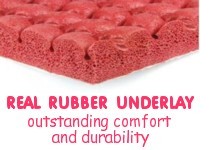 Rubber underlays are regarded as a more traditional style of underlay than the foam types, but the choice has narrowed over the years, as the foam underlays have become more popular. Rubber underlays are split between three main types, namely waffle rubber, sponge rubber and dense rubber.
Rubber underlays are regarded as a more traditional style of underlay than the foam types, but the choice has narrowed over the years, as the foam underlays have become more popular. Rubber underlays are split between three main types, namely waffle rubber, sponge rubber and dense rubber.
The waffle and sponge rubber underlays are often graded by their roll weight per 15 square metres, typically as 65lb, 85lb, 100lb and so on, up to around 150lb, the greater the weight, the more durable and hardwearing the product is, giving longer life to your carpet. In recent years the waffle rubber underlays have become less popular and sales are greatly exceeded by sponge rubber underlays.
Dense Rubber underlays are usually graded by their thickness rather than weight, these underlays being a little firmer underfoot than the waffle and sponge rubber underlay varieties, but giving excellent carpet support, especially in heavy foot traffic areas.
Examples of sponge rubber underlays are Tredaire Colours Red, Total Luxury and Silenzia Emerald
FELT UNDERLAY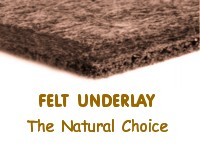 Regarded by many as an old-fashioned product, this style of product is making a comeback with the environmentally aware section of the buying public. Made from woollen and/or synthetic waste material often the by-product of carpet manufacture, which might otherwise end up in landfill sites. For good durability, choose a heavier weight.
Regarded by many as an old-fashioned product, this style of product is making a comeback with the environmentally aware section of the buying public. Made from woollen and/or synthetic waste material often the by-product of carpet manufacture, which might otherwise end up in landfill sites. For good durability, choose a heavier weight.
Examples of felt underlay are Knightsbridge Supreme and Kensington DeLuxe which is a combination felt and rubber underlay by Duralay.
ENVIRONMENTALLY FRIENDLY UNDERLAY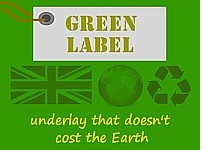 This terminology is applied to underlays which are often manufactured from recycled products. Felts using woollen and/or synthetic materials (see above), PU foam underlays using granulated offcuts of furniture foam and dense rubber underlays made from granulated rubber made from the recycling of tyres.
This terminology is applied to underlays which are often manufactured from recycled products. Felts using woollen and/or synthetic materials (see above), PU foam underlays using granulated offcuts of furniture foam and dense rubber underlays made from granulated rubber made from the recycling of tyres.
Over the past few years the PU foam underlays have become the most popular due the the ease in which they can be transported and fitted. Offcuts and waste foam are chipped and then re-bonded to form underlay in to a pre-determined thickness, usually between 7mm and 12mm thick, the core of the foam underlay usually being multi-coloured.
SPECIAL PURPOSE UNDERLAYS - UNDERFLOOR HEATING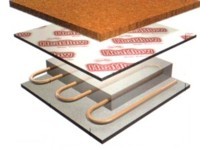 There are a number of underlays made for specific purposes such as use with underfloor central heating. When considering which range to opt for, bear in mind that the lower the tog value, the more efficient your underfloor heating will prove to be. Most low tog underlays for carpet will be thinner than the majority of other carpet underlays available, in order to achieve a low tog rating, but at the top end some do combine extra thickness and a low tog value, but this does come with a slightly higher price tag. Most foam underlays are generally not suitable for use with underfloor heating as they have a high tog value, with the exception of those that are specifically made for this purpose.
There are a number of underlays made for specific purposes such as use with underfloor central heating. When considering which range to opt for, bear in mind that the lower the tog value, the more efficient your underfloor heating will prove to be. Most low tog underlays for carpet will be thinner than the majority of other carpet underlays available, in order to achieve a low tog rating, but at the top end some do combine extra thickness and a low tog value, but this does come with a slightly higher price tag. Most foam underlays are generally not suitable for use with underfloor heating as they have a high tog value, with the exception of those that are specifically made for this purpose.
Suitable underlays for use with under floor heating include Aria Heatwave, Duralay Heatflow, and Easyflow
SPECIAL PURPOSE UNDERLAYS - WOOD & LAMINATE
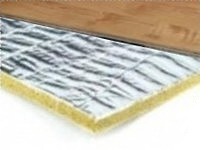 There are also underlays made specifically for laminate and wood flooring - do not use ordinary carpet underlay for this purpose, it could be a very costly mistake. There is a choice between foam or rubber products, ranging in thickness from around 2mm up to around 4mm, do not be tempted to use anything much thicker than this, it may cause the joints to open up or break away.
There are also underlays made specifically for laminate and wood flooring - do not use ordinary carpet underlay for this purpose, it could be a very costly mistake. There is a choice between foam or rubber products, ranging in thickness from around 2mm up to around 4mm, do not be tempted to use anything much thicker than this, it may cause the joints to open up or break away.
Gold Standard and Easyflow Wood & Laminate are excellent products for this purpose, the latter being also suitable for use above underfloor heating installations
SPECIAL PURPOSE UNDERLAYS - DOUBLE STICK
Some installations require the carpet to be adhered to the underlay and that the underlay be adhered to the floor. Sisal and Seagrass are examples of floorcoverings which should be fitted using this technique. Many contract installations, such as in offices, shops and pubs may also require this technique. The majority of underlays are not suitable for double sticking, be sure to select the correct type of underlay for these installations.
Products in this category include Cloud 9 Contract and Cloud 9 Super Contract



